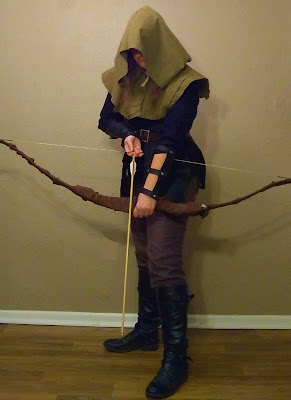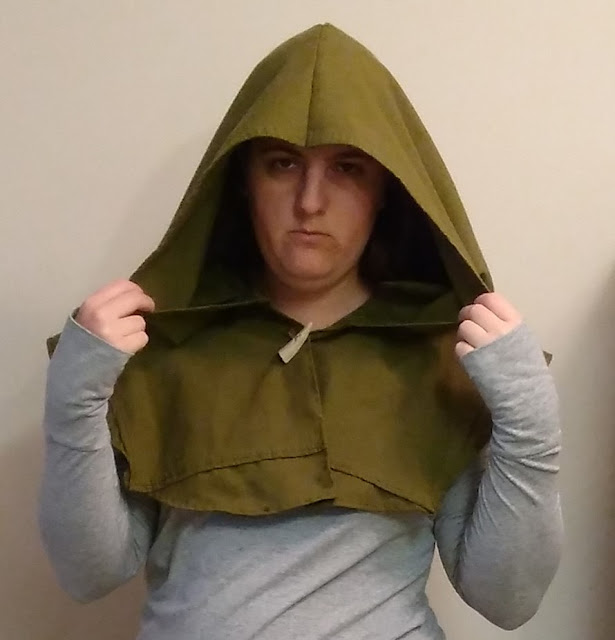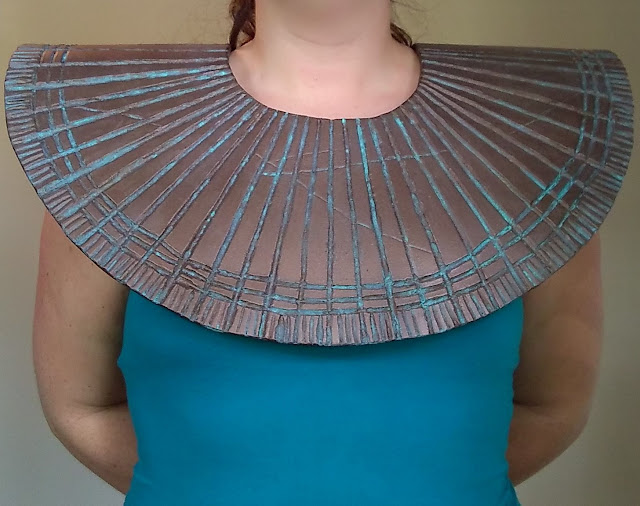Half-Elf Ranger costume build
Every time the medieval fair rolls around I'm ready to try another costume variation. In the past I've gone as a Pict warrior, berserker, temple guard, mercenary, and a Jedi (because really the only thing missing from Europe's medieval era is a laser-sword-wielding monk from a galaxy far away). But this year I aimed to create a character drawn from the rules and world of Faerun, as featured in the role-playing game Dungeons and Dragons.
Asking me why I chose this is a totally rational question. I have never played Dungeons and Dragons, or any of its spinoffs or imitators. Nor have I explored the world of live-action roleplaying (aka LARPing). But I have seen some of the movies inspired by the franchise, and I like the structure and world that it's built. Dungeons and Dragons provides an insane amount of background for a fictional universe's terrain, peoples, mythology, and magic. There are also several online character generators that help you build balanced and compelling characters, and give suggestions on backstory, strengths and weaknesses, character arcs, motivations, and a host of other useful odds and ends. Basically, character creation for dummies. Which is a great tool and challenge for costuming. Each piece of the costume should contribute to telling people about your character, and a little can go a long way.
Dungeons and Dragons itself was heavily influenced by Tolkien's Lord of the Rings, which suited me just fine. I always liked the idea of being Strider, to be that shifty-looking ranger sitting in the tavern or roving the wilds. The whole path to kingliness seemed like a drag, but defending unwitting hobbits from the dangers of the unknown is pretty cool. The elves of Middle Earth are also an interesting bunch, bound heavily to nature and yet ethereal and alien. I'm also a great fan of Spock (hold on I'll explain) and other characters that are half-this-half-that, and have that fascinating conflict and struggle of not quite fitting in anywhere. Thus I decided on a creating my own version of that: a half-elf ranger.
Another benefit to using Dungeons and Dragons as a touchstone for creating your own high fantasy character is it's hip-deep in examples and drawings for inspiration. Since it is primarily drawn from the imagination (rather than a particular source in a movie or book), people have long drawn or even commissioned drawings of their characters to explore and commemorate their hours played. So I explored the internet to get ideas for what elements I'd need to say "this is a half-elf ranger tread carefully." The drawings below are the major inspirations, and at the end of this post I've listed there source websites as best as I can tell.
1. Tabard
If I remember correctly, I bought this black leather tabard for maybe $30 at a previous medieval fair. It's a very simple design, with grommets for lacing tight the sides and the front. I've used this routinely for medieval fair costumes for years, it's a nice basic piece I've used for a berserker, temple guard, bounty hunter, shaman, etc. If you have leather or "leather" vinyl you could probably make something like this with not much expertise. You can also buy it, but watch it because they come in a range of prices and can get pretty expensive depending on the quality of leather and the craftmanship, potentially ranging hundreds of dollars.
2. Shirt
I picked up this olive-green shirt in a thrift store for about $4. It's not what SCA would call an authentic design for a medieval shirt, but it's simple and flowing, a good natural color. The textural detail adds a little something I think would be consistent with a rough-cut ranger, which seems to kind of mimic scales or feathers. Medieval shirts aren't all that complicated, they can be made with a very simple pattern, but if you're short on time this kind of shirt can easily work.
3. Pants
I bought these for about $5 at a thrift, originally for part of a Jedi costume. Once I realized I needed something closer to tan for Jedi pants, I started incorporating this as the basic breeches for medieval costumes. It's very comfortable, and the drawstring top and pockets are hidden under the long tunics and tabards. The key part of finding similar pants in a thrift store is to hunt by texture and color. It's mostly cotton, and the texture and look makes it look a little more roughly made, a mottled brown and tan that makes it look more authentic. The legs are also loose enough to be tucked into the tops of boots.
4. Hood
I've always been a fan of Robin Hood, so naturally I wanted my ranger to have some sort of hood or cloak. The design of this hood doesn't have a lot of fabric, but it has enough to protect the head and shoulders from the weather. It also shouldn't interfere too much with arm movement. This roughly made forester hood was made out of four cloth napkins and an antler button, a process you can see here.
5. Boots
The black leather-like boots are another thrift store buy, I think they cost between $8 and $10. Not strictly what a forester or ranger would normally wear, who would be more likely to have softer soles with a more moccasin-type design for walking. The heel makes them more consistent with riding boots, but they're comfortable enough for a day at the fair and most people wouldn't note the distinction. Black matches the tabards and ensures that they don't blend too closely with the pants.
6. Belt
This is a nice brown leather belt I found for $2 at a thrift store. It's just the right length for a waist belt, and wide enough to accommodate the belt pouch and dirk.
No medieval type costume is complete without some sort of weapon. Unlike conventions, authenticity of weaponry and costumes means you're much more likely to see people walking around with something other than foam or plastic weaponry. Several vendors at medieval fairs sell everything from display to stunt weapons, which of course encourages this mentality. However, security at the fair usually means that the weapon must be "peace-tied", means strapping it into the scabbard so it can't be drawn (AKA otherwise making it safer to carry around). Dork that I am, I've long had the ambition to buy my own stunt weapons, and my shining purchase was the dirk you see pictured below. For those behind on their study of ancient weapons, a dirk is a long, hilt-less dagger designed for stabbing.
8. Belt pouch
Like the tabard, this is another medieval fair purchase. The craftmanship is excellent and it wears well, I think this was maybe $15 to $20. It's also nice because I've also been able to use it for steampunk and Jedi costumes.
9. Bracers
Although this ranger won't be carrying around a bow and quiver, another nice addition are a pair of bracers. Though not truly armor, they function to secure sleeves and protect the forearm from the slap of a bowstring. I made a pair out of the black leather from a thrift store purse, a process you can see here.
10. Ears
If you're going for an elf, then you need the pointed ears. You may be able to find them in a Halloween or party store, but you're better off buying a little better quality online or from a fair. I bought mine from Aradani Costumes for about $10, and paid a few more dollars for spirit gum and painting them to a skin tone. I picked wrong on skin tone, I guess I'm more "medium" than the ordered "light", but with the long hair and ear cuffs to hide the transition it's not as critical. Also you can buy them unpainted and paint them yourself to get a better match. I chose the "wood elf" style, which is more consistent with a half-elf in Dungeons and Dragons and the Lord of the Rings elves. They also look pretty close to Vulcan ears, which are likely to come in handy later.
11. Weasel friend
OK, so in the forums the weasel is not exactly the first choice for a ranger's companion. But really, if you could have a weasel companion, wouldn't you? Small, stealthy, wily, and ready at all times to go for the throat. Also known as the furry tube of destruction. These guys are pretty easy to find in a thrift store or antique store, unaltered like this or sometimes made into a collar. I've had Loki here for awhile, I can't remember what I spent but it can't be more than $20.
12. Bow
What's a ranger without a bow? Or an elf without a bow? So naturally I had to include this as one of my character's costume pieces. It's a bit awkward to carry around, liable to poke someone's eye out, but it's definitely a key element of this costume. Luckily I already have a recurved bow, so to make it work as a costume piece I wrapped it with scraps of brown fabric to hide the fact it's not make of natural materials.
13. Crystal artifact
This is an optional prop, a piece a loot the character might have picked up in her travels. I made this from a puck light, ballpoint pens, and some paint, glue, and moss. My tutorial on making this project, which could be adapted for all sorts of genres, is here.
Inspiration Picture Credits:
1. https://www.artstation.com/artwork/lOZYe
2. https://maindekor.com/20-fantasy-character-art-for-your-dnd-campaigns-give-you-more-imagination/8_dnd-character-art/#main
3. http://lesly-oh.tumblr.com/post/171946943087/hoona
4. https://www.deviantart.com/greysmartwolf/art/Milva-487740264
5. https://www.artstation.com/artwork/female-half-elf-ranger
6. https://www.pinterest.com/pin/157626055692883422/ (original source unknown)
7. https://www.artstation.com/artwork/GmJXa
8. https://www.deviantart.com/yamaorce






























Comments
Post a Comment